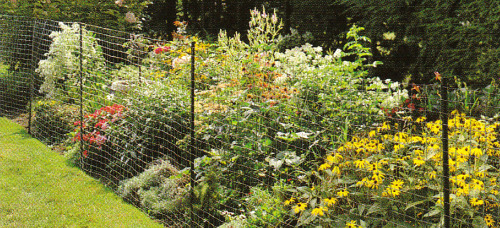
When it comes to the subject of “welded versus woven wire” fences, it may be more helpful to consider it more of a comparison, as both certainly have various merits in their favor. The first aspect to consider is the structure of each. Welded mesh fencing is created by laying wires in a simple horizontal and vertical latticework, with either square or rectangular spaces. The intersections of these wires are spot-welded to create a sheet. However, woven fences are created through a process that is quite different and much more complicated. Using machinery, wire is loosely twisted into a gentle spiral, with each overlapping at the ends. With a quick twist, the link is made permanent and the distinctive “zig-zag” diamond shape is formed. In modern machinery, this process takes half the time thanks to a “double helix” process.
By understanding their basic structures, it is easy to see their functional merits. A woven wire fence's linked yet loose structure allows for a large amount of bend, twist and pull without breaking -- a perfect design if you have grazing livestock to contain. In some styles of woven agricultural fence, the vertical wires are one continuous strand. This makes a very strong and secure mesh that will hold together well when under pressure. There is an unfortunate disadvantage to “chain-link” fence, another type of woven mesh. This fencing is only fully effective so long as every link remains strong. Once cut, it’s only a matter of time before this form of fence will become untangled and inefficient.
Welded wire fencing, which has a structure that is solid and inflexible, is ideal for a firm and definite barrier. When cut, the wires will not begin to unravel from one another. The disadvantages of this fencing type can be seen in situations when pressure is introduced, such as livestock in need of a leaning post or any sort of vehicular crash. If weight is applied, it’s difficult for a welded wire fence to spring back to shape. It will likely deform permanently and need replacing.
Need some more advice? Louis E. Page has over 120 years of experience in the fencing business and would love to help you out. Feel free to contact us for all your fencing needs. Family-owned and operated since 1893, we’d love the opportunity to help you find what you need.







![🌲 [Hidden Hero] What Most People Overlook But Can’t Afford To](https://content.cdntwrk.com/mediaproxy?url=https%3A%2F%2Fwww.louispage.com%2Fhs-fs%2Fhubfs%2FChatGPT%2520Image%2520Dec%252011%252C%25202025%252C%252009_24_15%2520AM.png%3Fwidth%3D753%26height%3D1130%26name%3DChatGPT%2520Image%2520Dec%252011%252C%25202025%252C%252009_24_15%2520AM.png&size=1&version=1765476183&sig=ab9c3aeedba193e746f2fd0de82eaafb&default=)















